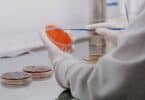Penicillin is an antibiotic used to fight some types of infections caused by bacteria.
The discovery of penicillin occurred in 1929 when Alexander Fleming observed that the mold of the genus Penicillium blocked the growth of bacteria.
After Fleming’s discovery, the University of Oxford began research on mice 10 years later. The result of these investigations saved thousands of lives in World War II, and penicillin was then considered a miracle drug.
What is penicillin?
It is a drug used for its antibiotic properties. It is derived from the fungus Penicillium chrysogenum.
Penicillins are part of a large family of drugs known as beta-lactams. These are antibiotics that share similarities in their molecular structure.
Penicillins bind to peptidoglycans in bacteria, which are molecules found in their walls. When the bacteria try to divide, the penicillin prevents the proteins in the wall from assembling correctly. The result is that the bacteria break down and die.
Types of penicillin
There are two groups of penicillins. Natural penicillins are those derived directly from P. chrysogenum. Only penicillin G or benzylpenicillin and penicillin V or phenoxymethylpenicillin are found in this group.
Semi-synthetic penicillins are drugs made in a laboratory to mimic natural penicillins. In this classification there are 4 main groups:
- Aminopenicillins: ampicillin, amoxicillin, and hetacillin.
- Broad spectrum penicillins: mezlocillin, piperacillin, ticarcillin, carbenicillin.
- Anti-staphylococcal penicillins: cloxacillin, nafcillin, dicloxacillin, oxacillin.
- Beta-lactamase inhibitor: clavulanic acid.
Currently, many bacteria have developed resistance to penicillin. For this reason, combinations of penicillins are frequently used to help overcome resistance and fight infection.
Uses of penicillin
Penicillin is used to kill some bacterial infections. Penicillin does not work to treat infections caused by viruses, fungi, or parasites.
The bacteria that can be killed with penicillin are known as “gram-positive bacteria”, which have peptidoglycan in their outer cell wall. Gram-positive bacteria stain pink on Gram’s stain due to peptidoglycans.
Gram-positive bacteria that can be treated with penicillins:
- Clostridium.
- Listeria.
- Neisseria.
- Staphylococcus
- Streptococcus.
- Peptostreoticiccus.
In the case of semisynthetic penicillins, they have a slightly wider range of action and can fight infections married to:
- H. influenzae.
- E. Coli, pneumococci.
- Salmonella.
- Some strains of staphylococci.
- Pseudomonas aeruginosa.
- Shigella.
The infectious diseases in which penicillins can be used are:
- Ear infections.
- Pneumonia.
- Infections in the paranasal sinuses.
- Gonorrhea (without complications).
- Meningitis.
- Urinary tract infection (some).
- Endocarditis.
- Skin infections.
- Among other.
Side effects of penicillins
Penicillins are generally harmless to most. However, they can sometimes cause mild and transient side effects that do not require treatment. But, in rare cases, the side effects can be so dangerous that they are life-threatening.
Common side effects of penicillins:
- Nausea or vomiting.
- Stomach ache.
- Headache.
- Diarrhea.
- Muscle spasms.
- Vaginal yeast infection.
- Rash or hives.
- Fever and angioedema (less frequent).
Penicillin allergy
It is a serious side effect associated with the use of penicillins. It is an exacerbated reaction of the immune system against penicillin. It is very rare. It occurs between 1 to 5 cases per 100,000 people.
Normally the immune system is responsible for reacting and fighting bacteria or dangerous substances that enter the body. However, it can sometimes react against drugs by believing that it is an invader.
Penicillin allergy symptoms
Penicillin allergy is characterized by the appearance of the following symptoms within the first hour after taking the medication:
- Cough.
- Fever.
- Itchy red bumps on the skin (hives).
- Runny nose.
- Itchy and watery eyes.
- Swelling of the skin.
Penicillin Anaphylaxis
It is a severe allergic reaction. You should call 911 or go to the emergency room immediately if you have any of the following symptoms after taking penicillin:
- Fast or irregular heartbeat.
- Severe skin rash
- Swelling in the face, tongue, or throat.
- Feeling of impending doom.
- Lightheadedness or fainting.
- Trouble breathing.
- Tightness in the throat.
- Wheezing in the chest.
If proper treatment is not received immediately, penicillin anaphylaxis can lead to shock, respiratory or cardiac failure, coma, and death.
Also, penicillins may cause inflammatory kidney disorders, they also occur due to an exaggerated immune reaction. Symptoms are nausea, skin rash, drowsiness, reduced urine output, vomiting, and fluid retention.
Drug interaction
Combining penicillin with anticoagulant medications, diuretics, among others, can cause alteration in its functions. Consult with your doctor if you find yourself taking any medication or supplement.
Conclusion
Penicillins are a great ally to fight bacterial infections. Its indiscriminate use has caused many bacteria today to become resistant to penicillins.
To stop this bacterial evolution, do not take antibiotics if your doctor has not instructed you. Also, fully comply with the treatment cycle prescribed by your doctor.
References
- Yuson CL, Katelaris CH, Smith WB. ‘Cephalosporin allergy’ label is misleading. Aust Prescr. 2018 Apr;41(2):37-41. doi:10.18773/austprescr.2018.008
- Lobanovska M, Pilla G. Penicillin’s discovery and antibiotic resistance: Lessons for the future? Yale J Biol Med. 2017;90(1):135-45.
See Also
Covid19 Symptoms Day by Day
Low Blood Sugar Symptoms
Guide to HIV and AIDS









